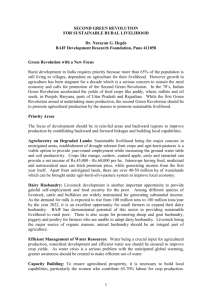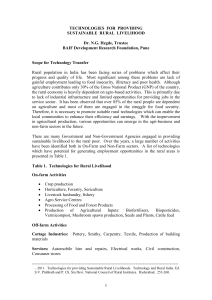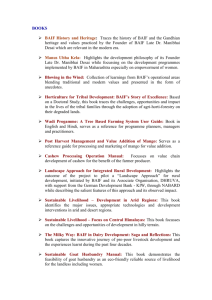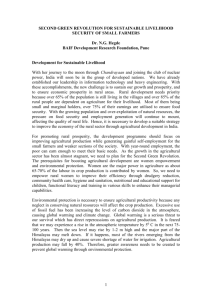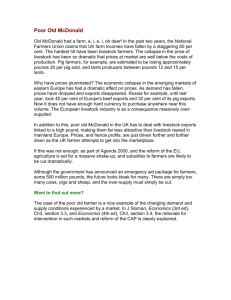challenges of rural development and opportunities for providing
advertisement
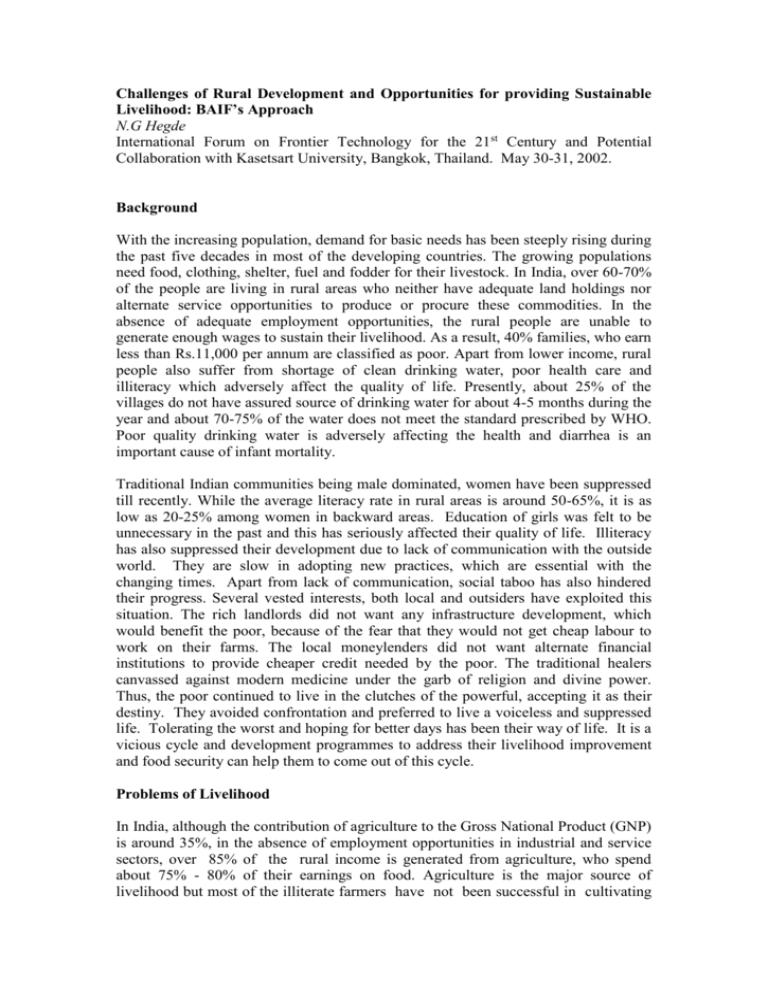
Challenges of Rural Development and Opportunities for providing Sustainable Livelihood: BAIF’s Approach N.G Hegde International Forum on Frontier Technology for the 21st Century and Potential Collaboration with Kasetsart University, Bangkok, Thailand. May 30-31, 2002. Background With the increasing population, demand for basic needs has been steeply rising during the past five decades in most of the developing countries. The growing populations need food, clothing, shelter, fuel and fodder for their livestock. In India, over 60-70% of the people are living in rural areas who neither have adequate land holdings nor alternate service opportunities to produce or procure these commodities. In the absence of adequate employment opportunities, the rural people are unable to generate enough wages to sustain their livelihood. As a result, 40% families, who earn less than Rs.11,000 per annum are classified as poor. Apart from lower income, rural people also suffer from shortage of clean drinking water, poor health care and illiteracy which adversely affect the quality of life. Presently, about 25% of the villages do not have assured source of drinking water for about 4-5 months during the year and about 70-75% of the water does not meet the standard prescribed by WHO. Poor quality drinking water is adversely affecting the health and diarrhea is an important cause of infant mortality. Traditional Indian communities being male dominated, women have been suppressed till recently. While the average literacy rate in rural areas is around 50-65%, it is as low as 20-25% among women in backward areas. Education of girls was felt to be unnecessary in the past and this has seriously affected their quality of life. Illiteracy has also suppressed their development due to lack of communication with the outside world. They are slow in adopting new practices, which are essential with the changing times. Apart from lack of communication, social taboo has also hindered their progress. Several vested interests, both local and outsiders have exploited this situation. The rich landlords did not want any infrastructure development, which would benefit the poor, because of the fear that they would not get cheap labour to work on their farms. The local moneylenders did not want alternate financial institutions to provide cheaper credit needed by the poor. The traditional healers canvassed against modern medicine under the garb of religion and divine power. Thus, the poor continued to live in the clutches of the powerful, accepting it as their destiny. They avoided confrontation and preferred to live a voiceless and suppressed life. Tolerating the worst and hoping for better days has been their way of life. It is a vicious cycle and development programmes to address their livelihood improvement and food security can help them to come out of this cycle. Problems of Livelihood In India, although the contribution of agriculture to the Gross National Product (GNP) is around 35%, in the absence of employment opportunities in industrial and service sectors, over 85% of the rural income is generated from agriculture, who spend about 75% - 80% of their earnings on food. Agriculture is the major source of livelihood but most of the illiterate farmers have not been successful in cultivating their land economically. They have been treating agriculture as a family tradition, following age old practices and adopted new changes only after observing the success of their neighbours. Over 12-15% of the rural families are landless and among the land holders, 69% are marginal farmers with less than 1 ha holding (17% of the total land) and about 21% are small farmers with 1-2 ha holdings (34% of the land). Thus about 90% families own less than 51% lands, with a per capita holding of 0.19 ha. Out of the 147 million ha agricultural lands, about 60 million ha are located in arid zones, which are mostly owned by the poor families. As the chances of crop failure on these lands is very high, the farmers generally do not invest in external inputs like improved seeds, fertilisers and plant protection measures and end up with poor crop yields, even during normal years. Apart from private holdings, pastures and common lands owned by the government and community are also being used in many ways, particularly for fuel and fodder collection. The Government has reserved about 10% of the total land in each village for livestock grazing. The ownership of this land is with the Village Panchayat (Local Government) and all the members of the community have free access. The Panchayat has no control over the use while the community does not consider it to be their responsibility to manage the pasture. This has resulted in over-exploitation and denudation of the pastures. The same situation prevailed on village woodlots and community forests. Thus, in spite of land scarcity, over 50% of the total land are either idle or under-utilised. Such wastelands, unable to retain the rainwater are promoting soil erosion, flooding of rivers and silting of tank beds. They are also hosting a wide range of pests and diseases. Management of these wastelands to improve the productivity can revive the supply of fodder and fuel, facilitate the percolation of rainwater and improve agricultural production. Water is a critical input for human consumption as well as for crop production but grossly neglected by the community. Major sources of water supply are rainfall, lakes, rivers, snowy mountains and underground storage. Except wells and small tanks, the other sources of water are collectively owned by the community. However, the powerful lobbies and vested interests have been taking advantage of these water resources for their own benefits, while the poor have no means of utilising their share. This has been accelerating the economic imbalance between the small and large landholders. Rainfall is the main source of water for agricultural production in India. However, in the absence of adequate soil and water conservation practices, it is estimated that over 65% rainwater runs off, flooding the rivers. About 28% of the total cropping area in the country are under irrigation, where farmers have a tendency to use excessive water. In the absence of adequate training and demonstration, they believe that excess water can enhance their crop yields. Moreover, as the water charges are fixed on the basis of the area covered under irrigation instead of on the quantity of water supplied, farmers do not want to restrict the use of water. As a result of poor soil and water conservation measures, the average yield of food crops in India is only 1.9 tons/ha as compared to 4.0 tons/ha in China. Due to excessive use of water for irrigation, over 9.00 million ha fertile lands have turned into sodic and saline wastelands, thereby posing a serious threat not only to food security and employment generation but also to community health, biodiversity and the environment. Forests have been providing many direct and indirect benefits to rural communities. As against the recommended 33% of the total geographical area to be placed under forest cover, only 22% land is under the Forest Department in India. Out of this area, over 50% land is devoid of vegetation due to over-exploitation and biotic pressure. As a result, the existence of over 80 million tribals, who were dependent on forest products for livelihood has been threatened. Ill-effects of deforestation are evident in the form of shortage of fodder, fuel, timber, non-wood forest products and medicinal herbs. The indirect losses in the form of soil erosion, deepening of ground water table and reduction in green cover are far more serious. Deforestation has been directly suppressing agricultural production, which is yet to be realised by a major section of the rural society. Like community wastelands, the forests are under the ownership of the Government but these precious resources cannot be protected unless the local communities come forward to conserve it. Livestock is an important source of supplementary income. Mixed farming has been serving as an insurance against natural calamities, while supporting food security and nutrient recycling. India has over 500 million livestock, which include cattle, buffaloes, sheep and goats. Among them, cattle and buffaloes are popular for milk production. As milk is an important part of the Indian diet and bullock power is essential for farming and rural transportation, rural families maintain 2-3 animals but over 70% of them are uneconomical due to low genetic base and poor management. The average milk yield of cows in India is 987 kg/lactation as compared to 4233 kg in Europe. This is because out of the 100 million cattle, over 90% are indigenous which yield less than 250 kg milk per lactation, while about 10% of the crossbred yield about 2000 – 3000 kg milk per lactation. The poor and landless prefer to maintain sheep or goats and let them loose for grazing on community pastures. Such animals are a liability. Poor productivity of the land and livestock and inefficient use of forests are the causes of seasonal employment in villages. Small farmers have work only for 100-120 days for growing one crop in a year, which is not adequate to sustain their livelihood. Hence, they have to struggle to earn additional wages by working in irrigated areas or migrate to urban areas. The migration pattern varies with the region, opportunities and socio-economic status of the families. The poorest families, particularly the landless and marginal holders owning poor quality land tend to migrate with the entire family. Many tribal families migrate to cities as construction workers and return at the onset of the rains. Such migrations severely affect the quality of life, due to poor health, lack of education and social pressures leading to erosion of moral values. After independence, poverty alleviation was the major agenda of the Government of India. Thus various community development programmes were initiated to build the capabilities of the poor. These programmes provided skill oriented training to build the capabilities and supplied critical agricultural inputs either free or at subsided cost. However, most of these programmes did not succeed due to lack of people’s participation. They were suspicious about the relevance of the programme and also lost confidence in the programme due to frequent failures. Subsequently, they lost confidence in themselves and also lost initiatives to work hard. This situation can be termed as mental poverty or psychological poverty. Thus it is necessary to fight mental poverty through motivation, awareness and capacity building before initiating any livelihood activities. BAIF’s Approach BAIF Development Research Foundation (formerly registered as the Bharatiya Agro Industries Foundation) is a voluntary organisation, established in 1967, as a Public Charitable Trust. Considering the challenges in rural areas, BAIF has set its mission to create opportunities of gainful self-employment for the rural families, especially disadvantaged sections, ensuring sustainable livelihood, enriched environment, improved quality of life and good human values. This is being achieved through development research, effective use of local resources, extension of appropriate technologies and upgradation of skills and capabilities with community participation. BAIF is a non-political, secular and professionally managed organisation, presently operating in 12,000 villages in India. Family as a Unit for Development: BAIF considers poor rural family as a basic unit for development. This provides an opportunity to identify the target families who require different types of support to come out of poverty. Generally most of the community development programmes consider village as an unit of development where the well to do and influential sections of the society dominate over the poor and exploit the benefit to the maximum extent. Thus such development projects may often create a wider gap between the rich and poor with in the community. Focus on Quality of Life: The overall goal of BAIF is to ensure better quality of life, through promotion of various development activities related to livelihood, health, literacy and moral development. Starvation being the most serious form of poverty, livelihood programme was considered as a priority but it was soon realised that good health and education are basic needs even for taking up livelihood activities. With generation of income, good moral values are also essential for happiness. Excess money, without strong moral education has been distracting the youth towards unproductive and unethical activities. Hence, BAIF is emphasising on blending livelihood programme with education, health care and moral development activities. The essential components of moral development are - willingness to take part in community development, non-violence, de-addiction from alcohol, drugs, narcotics and gambling, respect for women and concern for environmental protection. These components are generally acceptable to the community, irrespective of their religious and ethnic backgrounds, which have brought about a significant change in the attitude of the target communities. Assured Livelihood: While promoting various development programmes, the primary goal is to help the target family to come out of poverty, with in a shortest period. The dairy development programme has a gestation period of 3-4 years, till the newly born calf comes into milk production. In land based development programmes the gestation period may vary from 2 to 6 years, depending on the type of farming systems practiced by the farmers. In case of arable crop production, the gestation period is short due to short rotation crops while the fruit and tree crops take 5-6 years to generate income. While promoting these income generation activities there are two critical factors which affect the success of the programmes. Firstly the programme should be well planned to generate substantial income to enable the participating families to come out poverty. Generally small farmers having poor quality land and livestock may not be able to earn substantial income with only one intervention. Hence multi-disciplinary programmes have the advantage. Similarly, small interventions such as kitchen garden, vermi-composting, homestead horticulture in isolation will not help the poor. These interventions can be helpful as a part of an integrated programme. The other important aspect is to provide support during the gestation period. Many of the poor who do not have any resources even to procure their daily ration, are likely to neglect their development work, if no support is available in the form of assistance or wages to ensure their food security. Hence different short term income generation activities need to be designed till the income starts generating from the major interventions. Women Empowerment: Involvement of women in all the development programmes right from the stage of project planning is essential. Although women represent 50% of the population, they also have the major responsibility of grooming children and procuring the basic needs required for food, fuel and fodder securities. Active participation of women in development programmes will help to identify their problems and reduce their drudgery. Environmental Protection: In all the development programmes conservation of the natural resources and protection of the environment are essentially built in, as these are critical for sustainable development. This is particularly important, while dealing with the poor as their primary objective is to earn their livelihood and the development organisations have the obligation to carefully design the programme to ensure environmental protection with income generation activities. Blending Development with Research and Training: For effective implementation of various development programmes, the development programmes are supported by applied research and training activities. It is realised that any development programme without research back up is outdated and any research programme without development and extension outlets is academic. Training of the field functionaries and farmers is essential for effective transferring of technologies from laboratories to the field. People’s Organisations: To sustain the benefits of various projects particularly after the completion of the project, BAIF has developed a strategy to promote grassroot level People’s Organisations, right at the initiation of the projects. Several types of local People’s Organisations such Self Help Groups (SHG), Village Level Planning Committees, Users Groups of various goods and services, Networks and Federations of SHGs and Village Level Organisations, processing and marketing cooperatives are some of the organisations promoted in the field. These organisations are helpful in motivating the members of the community, particularly the backward and shy members to sustain their interest and take active involvement in various development initiatives. These organisations are also effective in procuring necessary agricultural inputs, disseminating technology, organising post-harvest handling, processing and marketing the produce. Subsequently they work closely with the Panchayat Raj Institutions to participate in various states sponsored development activities as well as to ensure the welfare of their community. ‘Jana Uthan’ - Our New Approach Over the long field experience, BAIF has realised that the development organisations approach the rural communities with specific activities, which benefit only a few sections of the community, while the others are left out, due to lack of resources or skills. In this process, it is often the poor who are left out of these development programmes. Therefore to overcome this situation, the new approach – known as ‘Jana Uthan Approach’ has been developed. Under this approach, the Extension Workers interact with the local community with an open mind and to bring them together to identify the local problems. The community is then encouraged to interact closely and identify the members into 3-4 economic categories based on their income and the access to various resources. Then the local groups identify the resources and the opportunities for the individual families belonging to different categories with an objectives of bringing all the sections above poverty. In this process while the marginally poor get smaller support through 1 or 2 development intervention, to come out of poverty, the poorest families having limited resources are given opportunity to participate in multiple activities. Thus the poor have scope to earn their income from several sources and the chances of failure are low. This approach is helpful to maintain transparency of the programme and promotes harmony among the members of different economic categories. The Jana Uthan Approach also poses a challenge to the development agencies to find suitable solutions to the problems of the landless and resource poor families. This calls for the search of suitable off-farm production and service activities to be undertaken by the poor, particularly the landless. Some of the important off-farm activities are pottery, smithy, carpentry, textile and services such as automobile hire and repairs, electrical wiring and repairs, masonry, production of pre-casted materials, civil construction, consumer stores, etc. While the off-farm activities have serious limitation due to poor infrastructure for input supply and marketing, the success of most of the on-farm activities are dependent on the productivity and management of the natural resources. Presently, all the important natural resources like land, water, forest vegetation and livestock, which are critical inputs for providing gainful self-employment and generation of GNP are under-utilised. These resources which are the basic assets for providing sustainable livelihood are proving to be liabilities. Therefore, the strategy for sustainable development is to improve the productivity of the natural resources and develop the capabilities of the local communities to make optimum use of these resources for their livelihood. Efficient management of the natural resources can generate secondary resources, which in turn can provide additional employment opportunities. With this background, BAIF has developed a multi-disciplinary programme for sustainable management of natural resources, which include livestock development, watershed development, agroforestry and promotion of post-production and non-farm activities. These activities have good potential to provide employment opportunities even to the landless, small landholders and women, while conserving environment and biodiversity. Programme Impact Dairy Development: BAIF initiated livestock development programme through the upgradation of local cattle and buffaloes for milk production as most of the rural families including the landless maintain livestock most of the rural families benefited from this programme. Indeed the poor are more dependent on the livestock than the rich as they do not have adequate land and water resources to engage in agricultural development activities. Realising the drawback of the local cattle with respect to productive and reproductive inefficiencies, BAIF has taken up the crossbreeding of such low productive, nondescript cattle. The programme also covers the buffaloe improvement by breeding non-descript with improved breeds. Under this programme a cluster of 10-15 villages will be headed by a trained technician who will provide breeding services to cows and buffaloes at the door steps of the farmers, using frozen semen of superior sires. Motivation, awareness about the benefits, delivery of various services, regular follow up, technical guidance, timely health care, supply of critical inputs have been helpful to the farmers to take full advantage of this programme. Crossbred calves born at the door steps of the rural families come to milk production at the age of 28-32 months and yield about 2500-2700 kg milk per lactation (300 days). This programme encourages the farmers to stall feed their valuable animals and reduce the herd size by selling un-productive animals. A crossbred cow is able to contribute a net income of Rs.5000 per year apart from other benefits such as supply of milk for home consumption, particularly for children, dung for biogas and manure and efficient use of various agricultural by-products as feed. The programme provides an excellent opportunity for the empowerment of women and improve the eco-system by reversing the unhealthy trends of stray grazing, inbreeding and spread of diseases. A family with three crossbred cows is able to remain out of poverty and lead a sustainable livelihood. Presently, BAIF’s programme is spread over 40000 villages through 1400 cattle development centres in 12 states. Atleast 2 lakh female crossbred cattle and buffaloe calves are born every year and the value of the milk produced from this programme is over Rs. 1650 crores per annum. Presently at least 5 lakh families have taken advantage of this programme to come our of poverty. This programme has the potential to expend throughout the country, as milk is a staple food for the growing population in the country. Development of Community Pastures: In drought prone regions of Rajasthan, where rainfall is erratic, farmers are more dependent on livestock than on agriculture for their survival. In such areas the community pastures have been heavily degraded due to uncontrolled grazing. With the degradation of community lands, the other problems such as soil erosion, deforestation and depletion of ground water have been accelerated further affecting the natural resources. Therefore BAIF decided to take up community pasture development on a pilot basis in Bhilwara district of Rajasthan. Initially the work was undertaken at village Kavlas by identifying 10 ha of pasture land out of 200 ha belonging to a temple trust. The villagers were reluctant as there was a fear of land that the land brought under such development will not be available for their use. Fortunately, as BAIF was already operating a cattle development centre in the village, the villagers had full faith in the organisation and were willing to take part in this experiment. The project was initiated with the formation of a pasture committee taking one representative from each of the 10 communities. The major activities proposed were to dig trench cum mould for establishing live hedges, contour bunding, gully plugging, sowing of seeds of forage of legumes and grass species to enrich the quality of forage. Over the next 3 years, the villagers participated in protection, collection of seeds, harvesting grass and trimming of the trees grown in the pasture. The villagers were extremely happy to realise that with the investment of Rs.10,000 per ha they were able to generate output worth Rs.6000-7000 ever year in the form of fodder and fuelwood. Looking to the success, additional areas was brought under the community pasture development not only in Kavlas but also in 15 different villages in the Rajasthan. Apart from the production of forage there were several other benefits such as recharging the ground water, reduction in soil erosion resulting in improved agricultural production in the neighboring areas, rehabilitation of wild animals like blue bulls in the pasture which were damaging agricultural crops. There was good harmony established among various sections of the society and there was a direct benefit on the productivity of livestock in this villages. Looking to this success the Government of India has now provided additional support to expand this programme in about 200 villages. Water Resource Development: Development of water resources and wastelands are other important activities, having good potential for supporting the livelihood. However, with watershed development alone particularly the small farmers owning poor quality land, cannot take advantage as they do not have the capacity to invest in land development and critical agricultural inputs. Hence they do not take active part in such programmes. Therefore the strategy adopted is to combine watershed management with development of low productive agricultural lands and wastelands owned by the weaker sections of the society. As there is a close link between poor quality land and poverty, BAIF has been taking up the development of private lands on priority to ensure adequate income generation for the poor, before expecting them to participate in community land development. Such a step has helped to motivate the community to conserve the community pastures and forests in the future. In all the watershed development programmes, involvement of the community right from the stage of planning has been a critical factor, for the success. Mobilising the community through entry point activities and establishing effective communication through SHGs and village level planning committees, participation of the community in resource identification and development have been the important elements of the programme. With watershed development, introduction of the improved agricultural practices such as use of certified seeds, promotion of timely tillage operations, integrated pest management, supply of micro- credit to procure inputs, setting up of grain bank to meet the emergency needs of the poor etc. have played a very significant role in building the confidence of the community and sustain their interest. Active involvement of the local community in watershed development has also helped in tapping their traditional wisdom and come out with several innovations. In South Karnataka, where the soil is sandy and the annual rainfall is only 750 mm, traditional approach of contour bunding was not feasible and construction of percolation tanks could benefit only a few farmers having their land on lower portion of the grid. Hence the farmers come up with the idea of digging 1-2 farm ponds per hectare to retain rainwater in their own fields. Thus in a cluster of 4-5 villages near Mainahalli in Hassan District, 350 farm ponds were dug and interconnected to capture the surplus water coming out from the ponds located on higher elevations. The size of the pond varied from 6x6x3 m to 10x10x3 m and costed about Rs. 3,000-4,000 only in the form of labour. Such ponds could retain water upto December-January and this water could be used for watering fruit and vegetable crops, during the Kharif and Rabi seasons. Other major benefits were prevention of soil erosion, which resulted in improved soil productivity, recharging of the open wells and borewells, and revival of the old revulets. The yield of coconut plantation in the surrounding had also increased significantly. With effective recharging of ground water, farmers gained their confidence and brought their barren lands under fruit and plantation crops. It was estimated that over the four years the ground water table had increased by 3.79 m and 175 ha were brought under irrigation. Two ephemeral streams have started flowing throughout the year. The problem of drinking water has been completely solved. Apart from increased agricultural production, the community has gained confidence in their capabilities, which has helped them to take active part in other development programmes promoted by the Panchayati Raj Institutions and other community development programmes. Introduction of cattle development in the watershed has also played a very significant role in improving the economic viability of the programme. It has been observed that most prominent and immediate benefit of watershed development is conservation of soil and water, resulting in increased grass production on field bunds, borders and on all the available cultivated and non-cultivated lands. The advantage of this grass output can be harnessed only when the farmers own valuable livestock which can respond suitably through higher milk production. Such Multidisciplinary activities have helped in taking best advantage of the watershed development programmes. Tree Based Farming: While promoting land development programmes along with watershed development, tree based farming has several advantages. Tree are hardy, capable of withstanding harsh weather conditions and to provide income for a long period. However, crop selection is dependent on the soil productivity and moisture supply. Most of the small farmers prefer fruit crops, as they can earn regular income, although there is high demand for labour. Promotion of tree based farming on private wastelands for food security and income generation is a major programme of BAIF. This programme to promote agri-hortiforestry for food and fodder security and marginal lands also covers women empowerment, community health, drinking water supply, hygiene and sanitation and capacity building. The poor families participating in this programme establish drought tolerant fruit crops such as mango, cashew, tamarind, custard apple, ber, etc. on their marginal or wastelands covering 0.4 to 1.0 ha. The interspace is used for cultivating arable crops, which they have been growing earlier and the field bunds and borders are used to establish hardy shrubs and trees useful for fodder, fuel, timber and herbal medicines. This programme for rehabilitation of poor tribal families on their own degraded lands, popularly known as “Wadi” (Orchard Development) has helped over 25000 families to conserve and improve the productivity of the natural resources while improving their agricultural production. The green coverage of the land through fruit trees enabled them to earn regular income without destroying the vegetation. Efficient field bunding promoted soil and water conservation and active presence of the farmers in the field helped them to enhance their crop yields by 50-100% as compared to their normal yields. There were opportunities for them to meet their basic needs such as fodder, fuel, timber and medicinal herbs without depending on the community lands and forests. This not only saved their time but also enhanced their dignity and status in the society. Water resource development is one of the key activities, of the wadi programme which was required to nurture the fruit trees. While developing the water resources for establishing the fruit trees, the basic requirement of water for human and livestock consumption was also met and critical problems of securing safe drinking water was solved. Assured source of potable water helped in drudgery reduction. As poor quality of the water was an important cause of illness in rural areas, with the introduction of Wadi programme, major health problems could be solved. Further support was also given through training of local Dais (Mid-wives) and Health Workers and Networking of the local ‘Bhagats’ and Traditional Healers to take part in the community health care programme. With the organisation of women Self Help Groups (SHG’s) micro-credit could be availed to meet their consumptive and production needs. Through several on-farm as well as off-farm activities many families could enhance their income. Some of the important activities undertaken by the SHGs of tribal women were establishmen of fruit and forest necessaries vegetable cultivation, food processing and collection and processing of minor forest produce. Youth from landless and small land holding families were selected for training in various employment oriented skills such as carpentry, masonry, smithy, processing of fruits and vegetable and marketing. Apart from developing the wastelands for food production and generation of cash income, the project has also helped the farmers to build their capacity through various training and awareness activities, which have contributed to the success of the programme. While undertaking the Wadi development the members of the SHGs and local communities had taken very keen interest and came up with various innovative methods to solve their problems encountered in the field from time to time. Some of the innovative features of this programme were : Holistic Programme Approach Central Core Concept along with flexible elements tailor –made to the needs and resources Flexibility in programme design Dynamic and responsive to emerging needs Strong market sense Space for community initiates Draws upon healthy traditions from the local culture Injects knowledge and skills with demystification Emphasis on developing a cadre of community level technicians “Not mass production but production by the masses”. Developing leadership and capacities of self management Microfinance integrated as community banking approach Promoting people’s institutions. A family participating in this programme with 0.4 ha land is able to earn a net income of Rs.20,000 per year after 5-6 years, once the trees start bearing fruits. During this gestation period those families generate income from various sources such as cultivation of food and vegetable crops, raising of fruit and forestry plants, vermicomposting, mushroom production, production and processing of herbal medicines, and establishment of micro-entreprises. Sustaining their livelihood during the gestation period is very critical for the success of the Wadi Programme. Apart from the monetary gains, there has been a greater impact on the quality of life by way of drudgery reduction for women, education for their children, control of migration, non-consumption of alcohol and development of hard working culture. After establishing their orchards, these families have started taking up dairy husbandry to earn supplementary income while increasing their earnings the local groups also decided to protect their forests. With plenty of trees grown on their field bunds, they did not have to depend on the forests for meeting these needs. Hence they could easily conserve their forest resources. Looking to the success of the Wadi owners, many families in the surrounding have initiated horticultural development on their own. The beneficiaries of project which was first initiated in Vansda Tehsil of Valsad district in 1982 have established their fruit processing co-operative at Lachakadi village and their turn over during the last year was around Rs.1 crore, from the sale of mango pulp and pickles, processing vegetables and cashewnut. The society decided to set up an English Medium School in their village cluster and a part of the profit earned from their fruit processing unit was diverted to operate the school. They have also started weekly bazaars in various villages to boost their sales and encourage the local families to participate in trading. This has created greater awareness among the members of the community and reduced exploitation by outsiders. Many of the Wadi owners have participated in the local elections to occupy importation positions on the local Panchayat Raj and Cooperative Institutions. The programme has adequately empowered them to sustain their livelihood and social development. Looking to the success of this project, similar programmes have been replicated in other tribal areas by both by BAIF and other project implementing agencies. This programme has an excellent potential to replicate throughout the country, particularly in hilly regions.
